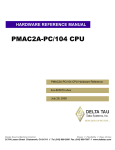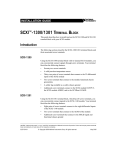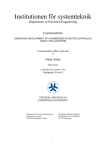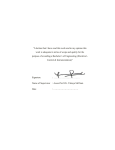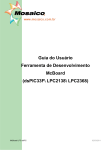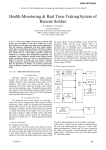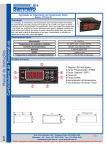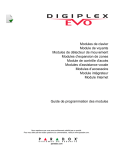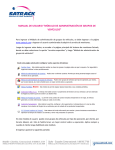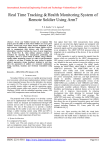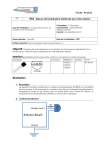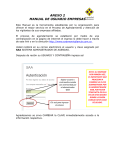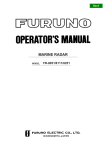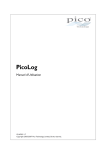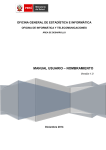Download manual de instalación ``monitor permanente de temperatura(mpt)
Transcript
MANUAL DE INSTALACIÓN “MONITOR
PERMANENTE DE TEMPERATURA(MPT)”
DISI-TEAM
1
ÍNDICE GENERAL
2
Índice general
Índice general
2
1 INTRODUCCIÓN
3
2 MATERIALES
2.1. Placa Arduino Uno . . . . . .
2.2. Sensor de Temperatura LM35
2.3. Resistencia 220 Ω . . . . . .
2.4. Protoboard . . . . . . . . . .
2.5. Cable USB Tipo AB . . . . .
2.6. Computador . . . . . . . . .
.
.
.
.
.
.
.
.
.
.
.
.
.
.
.
.
.
.
.
.
.
.
.
.
.
.
.
.
.
.
.
.
.
.
.
.
.
.
.
.
.
.
.
.
.
.
.
.
.
.
.
.
.
.
.
.
.
.
.
.
.
.
.
.
.
.
.
.
.
.
.
.
.
.
.
.
.
.
.
.
.
.
.
.
.
.
.
.
.
.
.
.
.
.
.
.
.
.
.
.
.
.
.
.
.
.
.
.
.
.
.
.
.
.
.
.
.
.
.
.
.
.
.
.
.
.
.
.
.
.
.
.
3 PROCEDIMIENTO
3.1. Instalación Placa - Sensor
3.2. Comunicación Placa - PC
3.3. Interfaz “Arduino” . . . . .
3.4. Envio Datos - Servidor . .
.
.
.
.
.
.
.
.
.
.
.
.
.
.
.
.
.
.
.
.
.
.
.
.
.
.
.
.
.
.
.
.
.
.
.
.
.
.
.
.
.
.
.
.
.
.
.
.
.
.
.
.
.
.
.
.
.
.
.
.
.
.
.
.
.
.
.
.
.
.
.
.
.
.
.
.
.
.
.
.
.
.
.
.
8
. 8
. 10
. 16
. 21
4 Anexos
4.1. Documento Oficial Sensor LM35 . . .
4.2. Documento Oficial Placa Arduino Uno
4.3. Documento Oficial Cable USB Tipo AB
4.4. Documento Oficial Protoboard . . . . .
.
.
.
.
.
.
.
.
.
.
.
.
.
.
.
.
.
.
.
.
.
.
.
.
.
.
.
.
.
.
.
.
.
.
.
.
.
.
.
.
.
.
.
.
.
.
.
.
.
.
.
.
.
.
.
.
.
.
.
.
.
.
.
.
.
.
.
.
Índice de figuras
.
.
.
.
.
.
.
.
4
4
4
5
5
6
6
26
26
40
42
45
49
Capítulo 1
INTRODUCCIÓN
La asignatura “Fundamentos de Electricidad y Magnetismo” dirigida por el profesor Jaime Villalobos Velasco, brinda a los estudiantes de la Universidad Nacional de Colombia la oportunidad de interactuar con proyectos de investigación
desde el inicio de su carrera y la posibilidad de trabajar en grupo con estudiantes
de otras carreras. En este caso se busca implementar un proyecto piloto de redes
de monitoreo en diferentes puntos cardinales de la ciudad de Bogotá. Para esto
se requiere principalmente: Placa “Arduino Uno”, sensor de temperatura LM35,
computador con conexión de internet constante.
El presente manual brinda una guia sobre la implementación de la estación de
monitoreo. Inicialmente se encuentran los materiales usados, enseguida los procedimientos que se requieren(Instalación Placa - Sensor, Comunicación Placa PC,Interfaz “Arduino”,Envio Datos - Servidor) , finalmente los anexos que el estudiante necesita para guia en el montaje. Se debe tener en cuenta que cada grupo
esta en la autonomía de presentar sus informes y en ningún momento se esta
obligando a los integrantes de la materia.
3
Capítulo 2
MATERIALES
2.1.
Placa Arduino Uno
Figura 2.1.1: Placa Arduino UNO.
2.2.
Sensor de Temperatura LM35
4
CAPÍTULO 2. MATERIALES
Figura 2.2.1: Sensor de Temperatura LM35.
2.3.
Resistencia 220 Ω
Figura 2.3.1: Resistencia 220 Ω.
2.4.
Protoboard
Figura 2.4.1: Protoboard usada para realizar el montaje.
5
CAPÍTULO 2. MATERIALES
2.5.
Cable USB Tipo AB
Figura 2.5.1: Cable USB Tipo AB.
2.6.
Computador
Figura 2.6.1: Computador de Escritorio.
6
CAPÍTULO 2. MATERIALES
Figura 2.6.2: Computador Portátil.
7
Capítulo 3
PROCEDIMIENTO
3.1.
Instalación Placa - Sensor
a) Planear el sitio donde se va a ubicar la estación de trabajo. Teniendo en cuenta
los siguientes aspectos:
-El monitor deberá estar ubicado cerca a una ventana para dejar el sensor en
la parte exterior de la habitación donde se sitúe.
-El computador que capture los datos tendrá acceso a internet todo el tiempo.
b) Revisar el estado de la placa. El sello de garantía debe estar en el respectivo empaque, en caso de encontrarse alguna anomalía informar directamente al
distrbuidor del mismo.
Figura 3.1.1: Empaque placa “Arduino Uno”.
8
CAPÍTULO 3. PROCEDIMIENTO
9
c) Revisar el estado del sensor de temperatura “LM35”, en caso de encontrarse
alguna anomalia informar directamente al distribuidor del mismo.
d) Consultar el manual del sensor en la sección “Anexos”, identificar las patas
(Vs, GND, Vout).
e) Soldar un cable a cada extremo de las patas del sensor, se recomienda dejar
cada cable con una longitud entre 1 y 2 metros para que se conecte a la protoboard.
f) Consultar el manual de uso de la protoboard en la sección “Anexos”, para realizar el montaje propuesto en el paso siguiente.
g) Realizar el montaje de la figura 3.1.2, cada equipo de trabajo esta en la autonomía de realizar el montaje según su caso particular, se debe tener en cuenta
que la placa no debe estar conectada.
Figura 3.1.2: Montaje Placa-Sensor.
CAPÍTULO 3. PROCEDIMIENTO
10
Figura 3.1.3: Estación Equipo de Trabajo.
3.2.
Comunicación Placa - PC
a) Identificar el sistema operativo del computador usado para la recepción de la
información.(Windows, Linux, Mac)
Figura 3.2.1: Sistemas Operativos Soporte Placa Arduino.
b) Para este manual de instalación, el sistema operativo usado es Windows. Nos
dirigimos al sitio web Arduino-Software.
CAPÍTULO 3. PROCEDIMIENTO
11
Figura 3.2.2: Sitio Web Arduino.
c) Descargamos el paquete “arduino-022.zip” con un peso aproximado de 85 Mb.
Figura 3.2.3: Descarga de paquete “arduino-022.zip”.
d) Se extrae el paquete “arduino-022.zip” en una ubicación que sea de fácil recordación para el equipo de trabajo.
CAPÍTULO 3. PROCEDIMIENTO
12
Figura 3.2.4: Extracción paquete “arduino-022.zip”.
e) Realizar la conexión entre el computador y la placa por medio del cable USB.
Como es un dispositivo desconocido se requiere el proceso de instalación.
f) Seleccionar la segunda opción del asistente de “Hardware Encontrado” como
se muestra en la figura 3.2.5.
CAPÍTULO 3. PROCEDIMIENTO
13
Figura 3.2.5: Pantallazo I (Proceso de Instalación).
g) Escoger la primera opción del asistente de “Hardware Encontrado”, luego ubicar la carpeta “Drivers” que se encuentra en el paquete del paso “d”, como se
muestra en la figura 3.2.6.
Figura 3.2.6: Pantallazo II (Proceso de Instalación).
CAPÍTULO 3. PROCEDIMIENTO
14
h) A continuación se realiza el proceso de instalación en la máquina, en el caso
de Windows Xp se elige la opción “Continuar”, como se muestra en la figura 3.2.7.
Figura 3.2.7: Pantallazo III (Proceso de Instalación).
i) El proceso de instalación del periférico ha finalizado de forma exitosa. En seguida se comprueba en “Administrador de Dispositivos” (Método Abreviado=Tecla
Windows+Pausa) que no se presenten conflictos e identificar la ubicación del
puerto.
CAPÍTULO 3. PROCEDIMIENTO
Figura 3.2.8: Pantallazo IV (Proceso de Instalación).
En este caso la placa esta ubicada en el puerto “Com 3“.
Figura 3.2.9: Pantallazo “Administrador de Dispositivos”
15
CAPÍTULO 3. PROCEDIMIENTO
3.3.
16
Interfaz “Arduino”
Teniendo en cuenta que la aplicación esta desarrollada en lenguaje “Java”, se
debe bajar el complemento en la siguiente página.Complemento Java.
Figura 3.3.1: Complemento “Java”.
a) En el paquete que se obtuvo, se ejecuta el archivo “Arduino”, como se muestra
en la figura 3.3.2.
Figura 3.3.2: Aplicación Arduino (Ejecutable).
CAPÍTULO 3. PROCEDIMIENTO
17
b) La interfaz de la aplicación presenta: Área de código, barra de herramientas y
barra de menús.
Figura 3.3.3: Interfaz “Arduino”.
c) Antes de realizar alguna tarea, se debe configurar el puerto. Nos ubicamos en
la parte superior en “Tools”, luego “Serial Port”, finalmente se selecciona el puerto.
No olvidar la asignación de la placa en la lista de dispositivos del computador.
CAPÍTULO 3. PROCEDIMIENTO
18
Figura 3.3.4: Configuración Puerto.
d) Ubicar en el área de trabajo el siguiente código, éste permite visualizar la captura de la temperatura en el intervalo de tiempo que el grupo de trabajo desee.Tener
en cuenta que la variable inicial “int tempPin = 0” concuerde con la conexión hecha anteriormente.
CAPÍTULO 3. PROCEDIMIENTO
19
Algorithm 3.1 Código de visualización de Datos “Placa”.
1
2
3
4
5
6
7
8
9
10
11
12
13
14
15
16
/ / declare variables
f l o a t tempC ;
i n t tempPin = 0 ;
void setup ( )
{
S e r i a l . begin ( 9 6 0 0 ) ; / / opens s e r i a l p o r t , s e t s data r a t e t o 9600 bps
}
void l o o p ( )
{
tempC = analogRead ( tempPin ) ; / / read t h e v a l u e from t h e sensor
tempC = (500 ∗ tempC ) / 1 0 2 4 . 0 ; / / c o n v e r t t h e analog data t o t e mp e r at u r e
S e r i a l . p r i n t l n ( tempC ) ;
d e l a y ( 5 0 0 ) ; / / w a i t one second b e f o r e sending new data
}
e) Ejecutar el icono “Verify”, esperar que en la parte inferior aparezca el mensaje
“Done Compiling”.
Figura 3.3.5: Tarea de verificación de código.
CAPÍTULO 3. PROCEDIMIENTO
20
f) Activar el icono “Upload”, esperar que en la parte inferior aparezca el mensaje
“Done Upload(Confirmar)”.
Figura 3.3.6: Tarea de Actualizar Placa - PC.
g) Visualizar la temperatura por medio de “Serial Monitor”.
CAPÍTULO 3. PROCEDIMIENTO
21
Figura 3.3.7: Serial Monitor.
3.4.
Envio Datos - Servidor
a) Instalar la aplicación “Instalador”, se encuentra publicada en el sitio web del
curso.Aplicación Ïnstalador".
Figura 3.4.1: Aplicación MPT.
CAPÍTULO 3. PROCEDIMIENTO
22
b) La aplicación “Estación de Monitoreo” queda instalada por defecto en el directorio(C:\estacionDeMonitoreo).
Figura 3.4.2: Directorio de Aplicación.
c) Ahora se debe registrar la estación de monitoreo, para esto nos dirigimos al sitio
web que se encuentra publicado en la página del curso.Registro de Estación En
esta parte se debe ubicar el punto en la ciudad de Bogotá, enseguida seleccionar
el puerto serial que fue asignado por el computador y finalmente se registra un
usuario por grupo de trabajo con el correo institucional.
CAPÍTULO 3. PROCEDIMIENTO
23
Figura 3.4.3: Registro de Estación.
d) Revisar el correo registrado en el enunciado anterior, a continuación se valida
la estación. Además de esto se debe copiar el archivo “conf.ini “ en el directorio
donde se instalo la aplicación.
Figura 3.4.4: Correo enviado por DISI-Team.
CAPÍTULO 3. PROCEDIMIENTO
24
Figura 3.4.5: Archivo “conf.ini” en directorio.
e) Dirigirse al monitoreo de estaciones Monitoreo de Estaciones para confirmar
que el proceso se ha culminado.
Figura 3.4.6: Monitoreo de Estaciones - Bogotá D.C
CAPÍTULO 3. PROCEDIMIENTO
25
f) Cualquier inquietud o sugerencia sobre el funcionamiento de la aplicación, favor
escribir a los siguientes correos: [email protected], [email protected].
Capítulo 4
Anexos
4.1.
Documento Oficial Sensor LM35
26
LM35
Precision Centigrade Temperature Sensors
General Description
The LM35 series are precision integrated-circuit temperature
sensors, whose output voltage is linearly proportional to the
Celsius (Centigrade) temperature. The LM35 thus has an
advantage over linear temperature sensors calibrated in
˚ Kelvin, as the user is not required to subtract a large
constant voltage from its output to obtain convenient Centigrade scaling. The LM35 does not require any external
calibration or trimming to provide typical accuracies of ± 1⁄4˚C
at room temperature and ± 3⁄4˚C over a full −55 to +150˚C
temperature range. Low cost is assured by trimming and
calibration at the wafer level. The LM35’s low output impedance, linear output, and precise inherent calibration make
interfacing to readout or control circuitry especially easy. It
can be used with single power supplies, or with plus and
minus supplies. As it draws only 60 µA from its supply, it has
very low self-heating, less than 0.1˚C in still air. The LM35 is
rated to operate over a −55˚ to +150˚C temperature range,
while the LM35C is rated for a −40˚ to +110˚C range (−10˚
with improved accuracy). The LM35 series is available pack-
aged in hermetic TO-46 transistor packages, while the
LM35C, LM35CA, and LM35D are also available in the
plastic TO-92 transistor package. The LM35D is also available in an 8-lead surface mount small outline package and a
plastic TO-220 package.
Features
n
n
n
n
n
n
n
n
n
n
n
Calibrated directly in ˚ Celsius (Centigrade)
Linear + 10.0 mV/˚C scale factor
0.5˚C accuracy guaranteeable (at +25˚C)
Rated for full −55˚ to +150˚C range
Suitable for remote applications
Low cost due to wafer-level trimming
Operates from 4 to 30 volts
Less than 60 µA current drain
Low self-heating, 0.08˚C in still air
Nonlinearity only ± 1⁄4˚C typical
Low impedance output, 0.1 Ω for 1 mA load
Typical Applications
DS005516-4
DS005516-3
FIGURE 1. Basic Centigrade Temperature Sensor
(+2˚C to +150˚C)
Choose R1 = −VS/50 µA
V OUT =+1,500 mV at +150˚C
= +250 mV at +25˚C
= −550 mV at −55˚C
FIGURE 2. Full-Range Centigrade Temperature Sensor
© 2000 National Semiconductor Corporation
DS005516
www.national.com
LM35 Precision Centigrade Temperature Sensors
November 2000
LM35
Connection Diagrams
TO-46
Metal Can Package*
SO-8
Small Outline Molded Package
DS005516-1
DS005516-21
*Case is connected to negative pin (GND)
N.C. = No Connection
Order Number LM35H, LM35AH, LM35CH, LM35CAH or
LM35DH
See NS Package Number H03H
Top View
Order Number LM35DM
See NS Package Number M08A
TO-92
Plastic Package
TO-220
Plastic Package*
DS005516-2
Order Number LM35CZ,
LM35CAZ or LM35DZ
See NS Package Number Z03A
DS005516-24
*Tab is connected to the negative pin (GND).
Note: The LM35DT pinout is different than the discontinued LM35DP.
Order Number LM35DT
See NS Package Number TA03F
www.national.com
2
TO-92 and TO-220 Package,
(Soldering, 10 seconds)
260˚C
SO Package (Note 12)
Vapor Phase (60 seconds)
215˚C
Infrared (15 seconds)
220˚C
ESD Susceptibility (Note 11)
2500V
Specified Operating Temperature Range: TMIN to T MAX
(Note 2)
LM35, LM35A
−55˚C to +150˚C
LM35C, LM35CA
−40˚C to +110˚C
LM35D
0˚C to +100˚C
If Military/Aerospace specified devices are required,
please contact the National Semiconductor Sales Office/
Distributors for availability and specifications.
Supply Voltage
Output Voltage
Output Current
Storage Temp.;
TO-46 Package,
TO-92 Package,
SO-8 Package,
TO-220 Package,
Lead Temp.:
TO-46 Package,
(Soldering, 10 seconds)
+35V to −0.2V
+6V to −1.0V
10 mA
−60˚C
−60˚C
−65˚C
−65˚C
to
to
to
to
+180˚C
+150˚C
+150˚C
+150˚C
300˚C
Electrical Characteristics
(Notes 1, 6)
LM35A
Parameter
Conditions
Tested
Typical
T MIN≤TA≤TMAX
± 0.2
± 0.3
± 0.4
± 0.4
± 0.18
T MIN≤TA≤TMAX
+10.0
Accuracy
T A =+25˚C
(Note 7)
T A =−10˚C
T A =TMAX
T A =TMIN
Nonlinearity
LM35CA
Design
Limit
Limit
(Note 4)
(Note 5)
± 0.5
± 1.0
± 1.0
± 0.35
Tested
Typical
± 0.2
± 0.3
± 0.4
± 0.4
± 0.15
Design
Units
Limit
Limit
(Max.)
(Note 4)
(Note 5)
± 0.5
˚C
± 1.0
± 1.0
˚C
˚C
± 1.5
± 0.3
˚C
+9.9,
mV/˚C
˚C
(Note 8)
Sensor Gain
(Average Slope)
+9.9,
+10.0
+10.1
Load Regulation
T A =+25˚C
(Note 3) 0≤IL≤1 mA
T MIN≤TA≤TMAX
Line Regulation
T A =+25˚C
(Note 3)
4V≤V S≤30V
± 0.4
± 0.5
± 0.01
± 0.02
Quiescent Current
V S =+5V, +25˚C
56
(Note 9)
V S =+5V
105
V S =+30V, +25˚C
56.2
V S =+30V
105.5
+10.1
± 1.0
± 0.1
± 0.4
± 0.5
± 0.01
± 0.02
131
91
± 3.0
± 0.05
67
56
68
56.2
133
91.5
± 1.0
mV/mA
± 3.0
± 0.05
mV/mA
mV/V
± 0.1
67
mV/V
µA
114
µA
116
µA
68
µA
Change of
4V≤VS≤30V, +25˚C
0.2
Quiescent Current
4V≤V S≤30V
0.5
2.0
0.5
2.0
µA
+0.39
+0.5
+0.39
+0.5
µA/˚C
+1.5
+2.0
+1.5
+2.0
˚C
1.0
0.2
1.0
µA
(Note 3)
Temperature
Coefficient of
Quiescent Current
Minimum Temperature
In circuit of
for Rated Accuracy
Figure 1, IL =0
Long Term Stability
T J =TMAX, for
± 0.08
± 0.08
˚C
1000 hours
3
www.national.com
LM35
Absolute Maximum Ratings (Note 10)
LM35
Electrical Characteristics
(Notes 1, 6)
LM35
Parameter
Conditions
Design
Limit
Limit
(Note 4)
(Note 5)
Typical
Accuracy,
T A =+25˚C
LM35, LM35C
T A =−10˚C
(Note 7)
T A =TMAX
± 0.4
± 0.5
± 0.8
± 0.8
T A =TMIN
Accuracy, LM35D
(Note 7)
LM35C, LM35D
Tested
± 1.0
± 1.5
± 1.5
T A =+25˚C
TA =TMAX
TA =TMIN
Nonlinearity
T MIN≤TA≤TMAX
± 0.3
T MIN≤TA≤TMAX
+10.0
± 0.5
Typical
± 0.4
± 0.5
± 0.8
± 0.8
± 0.6
± 0.9
± 0.9
± 0.2
Tested
Design
Units
Limit
Limit
(Max.)
(Note 4)
(Note 5)
± 1.0
˚C
± 1.5
± 1.5
± 2.0
± 1.5
˚C
˚C
˚C
˚C
± 2.0
± 2.0
± 0.5
˚C
+9.8,
mV/˚C
˚C
˚C
(Note 8)
Sensor Gain
(Average Slope)
+9.8,
+10.0
+10.2
± 0.4
± 0.5
± 0.01
± 0.02
± 2.0
V S =+5V, +25˚C
56
80
V S =+5V
105
V S =+30V, +25˚C
56.2
V S =+30V
105.5
Load Regulation
T A =+25˚C
(Note 3) 0≤IL≤1 mA
T MIN≤TA≤TMAX
Line Regulation
T A =+25˚C
(Note 3)
4V≤V S≤30V
Quiescent Current
(Note 9)
+10.2
± 5.0
± 0.1
± 0.2
158
82
± 0.4
± 0.5
± 0.01
± 0.02
± 2.0
56
80
161
± 0.1
mV/V
µA
138
82
91.5
mV/mA
mV/V
± 0.2
91
56.2
mV/mA
± 5.0
µA
µA
141
µA
Change of
4V≤VS≤30V, +25˚C
0.2
Quiescent Current
4V≤V S≤30V
0.5
3.0
0.5
3.0
µA
+0.39
+0.7
+0.39
+0.7
µA/˚C
+1.5
+2.0
+1.5
+2.0
˚C
2.0
0.2
2.0
µA
(Note 3)
Temperature
Coefficient of
Quiescent Current
Minimum Temperature
In circuit of
for Rated Accuracy
Figure 1, IL =0
Long Term Stability
T J =TMAX, for
± 0.08
± 0.08
˚C
1000 hours
Note 1: Unless otherwise noted, these specifications apply: −55˚C≤TJ≤+150˚C for the LM35 and LM35A; −40˚≤TJ≤+110˚C for the LM35C and LM35CA; and
0˚≤TJ≤+100˚C for the LM35D. VS =+5Vdc and ILOAD =50 µA, in the circuit of Figure 2. These specifications also apply from +2˚C to TMAX in the circuit of Figure 1.
Specifications in boldface apply over the full rated temperature range.
Note 2: Thermal resistance of the TO-46 package is 400˚C/W, junction to ambient, and 24˚C/W junction to case. Thermal resistance of the TO-92 package is
180˚C/W junction to ambient. Thermal resistance of the small outline molded package is 220˚C/W junction to ambient. Thermal resistance of the TO-220 package
is 90˚C/W junction to ambient. For additional thermal resistance information see table in the Applications section.
Note 3: Regulation is measured at constant junction temperature, using pulse testing with a low duty cycle. Changes in output due to heating effects can be
computed by multiplying the internal dissipation by the thermal resistance.
Note 4: Tested Limits are guaranteed and 100% tested in production.
Note 5: Design Limits are guaranteed (but not 100% production tested) over the indicated temperature and supply voltage ranges. These limits are not used to
calculate outgoing quality levels.
Note 6: Specifications in boldface apply over the full rated temperature range.
Note 7: Accuracy is defined as the error between the output voltage and 10mv/˚C times the device’s case temperature, at specified conditions of voltage, current,
and temperature (expressed in ˚C).
Note 8: Nonlinearity is defined as the deviation of the output-voltage-versus-temperature curve from the best-fit straight line, over the device’s rated temperature
range.
Note 9: Quiescent current is defined in the circuit of Figure 1.
Note 10: Absolute Maximum Ratings indicate limits beyond which damage to the device may occur. DC and AC electrical specifications do not apply when operating
the device beyond its rated operating conditions. See Note 1.
Note 11: Human body model, 100 pF discharged through a 1.5 kΩ resistor.
Note 12: See AN-450 “Surface Mounting Methods and Their Effect on Product Reliability” or the section titled “Surface Mount” found in a current National
Semiconductor Linear Data Book for other methods of soldering surface mount devices.
www.national.com
4
LM35
Typical Performance Characteristics
Thermal Resistance
Junction to Air
Thermal Response
in Still Air
Thermal Time Constant
DS005516-26
DS005516-25
Thermal Response in
Stirred Oil Bath
DS005516-27
Minimum Supply
Voltage vs. Temperature
Quiescent Current
vs. Temperature
(In Circuit of Figure 1.)
DS005516-29
DS005516-28
DS005516-30
Quiescent Current
vs. Temperature
(In Circuit of Figure 2.)
Accuracy vs. Temperature
(Guaranteed)
Accuracy vs. Temperature
(Guaranteed)
DS005516-32
DS005516-33
DS005516-31
5
www.national.com
LM35
Typical Performance Characteristics
(Continued)
Noise Voltage
Start-Up Response
DS005516-34
DS005516-35
The TO-46 metal package can also be soldered to a metal
surface or pipe without damage. Of course, in that case the
V− terminal of the circuit will be grounded to that metal.
Alternatively, the LM35 can be mounted inside a sealed-end
metal tube, and can then be dipped into a bath or screwed
into a threaded hole in a tank. As with any IC, the LM35 and
accompanying wiring and circuits must be kept insulated and
dry, to avoid leakage and corrosion. This is especially true if
the circuit may operate at cold temperatures where condensation can occur. Printed-circuit coatings and varnishes such
as Humiseal and epoxy paints or dips are often used to
insure that moisture cannot corrode the LM35 or its connections.
These devices are sometimes soldered to a small
light-weight heat fin, to decrease the thermal time constant
and speed up the response in slowly-moving air. On the
other hand, a small thermal mass may be added to the
sensor, to give the steadiest reading despite small deviations
in the air temperature.
Applications
The LM35 can be applied easily in the same way as other
integrated-circuit temperature sensors. It can be glued or
cemented to a surface and its temperature will be within
about 0.01˚C of the surface temperature.
This presumes that the ambient air temperature is almost the
same as the surface temperature; if the air temperature were
much higher or lower than the surface temperature, the
actual temperature of the LM35 die would be at an intermediate temperature between the surface temperature and the
air temperature. This is expecially true for the TO-92 plastic
package, where the copper leads are the principal thermal
path to carry heat into the device, so its temperature might
be closer to the air temperature than to the surface temperature.
To minimize this problem, be sure that the wiring to the
LM35, as it leaves the device, is held at the same temperature as the surface of interest. The easiest way to do this is
to cover up these wires with a bead of epoxy which will
insure that the leads and wires are all at the same temperature as the surface, and that the LM35 die’s temperature will
not be affected by the air temperature.
Temperature Rise of LM35 Due To Self-heating (Thermal Resistance,θJA)
TO-46,
TO-46*,
TO-92,
TO-92**,
SO-8
SO-8**
TO-220
no heat
sink
small heat fin
no heat
sink
small heat fin
no heat
sink
small heat fin
no heat
sink
Still air
400˚C/W
100˚C/W
180˚C/W
140˚C/W
220˚C/W
110˚C/W
90˚C/W
Moving air
100˚C/W
40˚C/W
90˚C/W
70˚C/W
105˚C/W
90˚C/W
26˚C/W
Still oil
100˚C/W
40˚C/W
90˚C/W
70˚C/W
Stirred oil
50˚C/W
30˚C/W
45˚C/W
40˚C/W
(Clamped to metal,
Infinite heat sink)
(24˚C/W)
(55˚C/W)
*Wakefield type 201, or 1" disc of 0.020" sheet brass, soldered to case, or similar.
**TO-92 and SO-8 packages glued and leads soldered to 1" square of 1/16" printed circuit board with 2 oz. foil or similar.
www.national.com
6
LM35
Typical Applications
DS005516-19
FIGURE 3. LM35 with Decoupling from Capacitive Load
DS005516-6
FIGURE 6. Two-Wire Remote Temperature Sensor
(Output Referred to Ground)
DS005516-20
FIGURE 4. LM35 with R-C Damper
CAPACITIVE LOADS
Like most micropower circuits, the LM35 has a limited ability
to drive heavy capacitive loads. The LM35 by itself is able to
drive 50 pf without special precautions. If heavier loads are
anticipated, it is easy to isolate or decouple the load with a
resistor; see Figure 3. Or you can improve the tolerance of
capacitance with a series R-C damper from output to
ground; see Figure 4.
When the LM35 is applied with a 200Ω load resistor as
shown in Figure 5, Figure 6 or Figure 8 it is relatively immune
to wiring capacitance because the capacitance forms a bypass from ground to input, not on the output. However, as
with any linear circuit connected to wires in a hostile environment, its performance can be affected adversely by intense electromagnetic sources such as relays, radio transmitters, motors with arcing brushes, SCR transients, etc, as
its wiring can act as a receiving antenna and its internal
junctions can act as rectifiers. For best results in such cases,
a bypass capacitor from VIN to ground and a series R-C
damper such as 75Ω in series with 0.2 or 1 µF from output to
ground are often useful. These are shown in Figure 13,
Figure 14, and Figure 16.
DS005516-7
FIGURE 7. Temperature Sensor, Single Supply, −55˚ to
+150˚C
DS005516-8
FIGURE 8. Two-Wire Remote Temperature Sensor
(Output Referred to Ground)
DS005516-5
FIGURE 5. Two-Wire Remote Temperature Sensor
(Grounded Sensor)
DS005516-9
FIGURE 9. 4-To-20 mA Current Source (0˚C to +100˚C)
7
www.national.com
LM35
Typical Applications
(Continued)
DS005516-11
FIGURE 11. Centigrade Thermometer (Analog Meter)
DS005516-10
FIGURE 10. Fahrenheit Thermometer
DS005516-12
FIGURE 12. Fahrenheit ThermometerExpanded Scale
Thermometer
(50˚ to 80˚ Fahrenheit, for Example Shown)
DS005516-13
FIGURE 13. Temperature To Digital Converter (Serial Output) (+128˚C Full Scale)
DS005516-14
FIGURE 14. Temperature To Digital Converter (Parallel TRI-STATE™ Outputs for
Standard Data Bus to µP Interface) (128˚C Full Scale)
www.national.com
8
LM35
Typical Applications
(Continued)
DS005516-16
* =1% or 2% film resistor
Trim RB for VB =3.075V
Trim RC for VC =1.955V
Trim RA for VA =0.075V + 100mV/˚C x Tambient
Example, VA =2.275V at 22˚C
FIGURE 15. Bar-Graph Temperature Display (Dot Mode)
DS005516-15
FIGURE 16. LM35 With Voltage-To-Frequency Converter And Isolated Output
(2˚C to +150˚C; 20 Hz to 1500 Hz)
9
www.national.com
LM35
Block Diagram
DS005516-23
www.national.com
10
LM35
Physical Dimensions
inches (millimeters) unless otherwise noted
TO-46 Metal Can Package (H)
Order Number LM35H, LM35AH, LM35CH,
LM35CAH, or LM35DH
NS Package Number H03H
SO-8 Molded Small Outline Package (M)
Order Number LM35DM
NS Package Number M08A
11
www.national.com
LM35
Physical Dimensions
inches (millimeters) unless otherwise noted (Continued)
Power Package TO-220 (T)
Order Number LM35DT
NS Package Number TA03F
www.national.com
12
LM35 Precision Centigrade Temperature Sensors
Physical Dimensions
inches (millimeters) unless otherwise noted (Continued)
TO-92 Plastic Package (Z)
Order Number LM35CZ, LM35CAZ or LM35DZ
NS Package Number Z03A
LIFE SUPPORT POLICY
NATIONAL’S PRODUCTS ARE NOT AUTHORIZED FOR USE AS CRITICAL COMPONENTS IN LIFE SUPPORT
DEVICES OR SYSTEMS WITHOUT THE EXPRESS WRITTEN APPROVAL OF THE PRESIDENT AND GENERAL
COUNSEL OF NATIONAL SEMICONDUCTOR CORPORATION. As used herein:
1. Life support devices or systems are devices or
systems which, (a) are intended for surgical implant
into the body, or (b) support or sustain life, and
whose failure to perform when properly used in
accordance with instructions for use provided in the
labeling, can be reasonably expected to result in a
significant injury to the user.
National Semiconductor
Corporation
Americas
Tel: 1-800-272-9959
Fax: 1-800-737-7018
Email: [email protected]
www.national.com
National Semiconductor
Europe
Fax: +49 (0) 180-530 85 86
Email: [email protected]
Deutsch Tel: +49 (0) 69 9508 6208
English Tel: +44 (0) 870 24 0 2171
Français Tel: +33 (0) 1 41 91 8790
2. A critical component is any component of a life
support device or system whose failure to perform
can be reasonably expected to cause the failure of
the life support device or system, or to affect its
safety or effectiveness.
National Semiconductor
Asia Pacific Customer
Response Group
Tel: 65-2544466
Fax: 65-2504466
Email: [email protected]
National Semiconductor
Japan Ltd.
Tel: 81-3-5639-7560
Fax: 81-3-5639-7507
National does not assume any responsibility for use of any circuitry described, no circuit patent licenses are implied and National reserves the right at any time without notice to change said circuitry and specifications.
CAPÍTULO 4. ANEXOS
4.2.
Documento Oficial Placa Arduino Uno
40
Arduino UNO Reference Design
TM
Reference Designs ARE PROVIDED "AS IS" AND "WITH ALL FAULTS". Arduino DISCLAIMS ALL OTHER WARRANTIES, EXPRESS OR IMPLIED,
REGARDING PRODUCTS, INCLUDING BUT NOT LIMITED TO, ANY IMPLIED WARRANTIES OF MERCHANTABILITY OR FITNESS FOR A PARTICULAR PURPOSE
+5V
2
PWRIN
+5V
GND
1
UCAP
UVCC
DD+
UGND
EXP
PAD
13
12
11 TXLED
10 RXLED
9 M8RXD
8 M8TXD
7
6
2
1
16MHz
Q2
2
5
4
RN1D 10K
100n
C5
DTR
+5V
1
2
USB boot En
1K
5 RN2D
4
C6
100n
+5V
XTAL2
2
4
6
8
1
3
5
ICSP
GND
ZIC1
1
10
9
21
20
22
7
8
RESET
XTAL2
XTAL1
AREF
AVCC
AGND
VCC
GND
(SCK)PB5
(MISO)PB4
(MOSI)PB3
(SS)PB2
(OC1)PB1
(ICP)PB0
(ADC5)PC5
(ADC4)PC4
(ADC3)PC3
(ADC2)PC2
(ADC1)PC1
(ADC0)PC0)
(AIN1)PD7
(AIN0)PD6
(T1)PD5
(T0)PD4
(INT1)PD3
(INT0)PD2
(TXD)PD1
(RXD)PD0
GND
TX
YELLOW
1K
6 RN2C
3
XTAL1
1
16MHz
XTAL2
R2
1M
XTAL1
AREF
UBOOT
RX
YELLOW
XT1
XT2
Y2
ATMEGA8U2-MU
C9
22p
GND
(CTS/HWB/AIN6/TO/INT7)PD7
(RTS/AIN5/INT6)PD6
(XCK/AIN4/PCINT12)PD5
(INT5/AIN3)PD4
(TXD1/INT3)PD3
(RXD1/AIN1/INT2)PD2
(AIN0/INT1)PD1
(OC0B/INT0)PD0
2
+5V
RESET
GND
ATMEGA8
M8RXD
M8TXD
GND
2
3
4
RESET
TS42
27
31
30
29
28
GROUND
GND
C8
1u
VCC
GND
22
23
25
26
5
C10
22p
100n
C7
(INT4/ICP1/CLK0)PC7
(OC1A/PCINT8)PC6
(PCINT9/OC1B)PC5
(PCINT10)PC4
(AIN2/PCINT11)PC2
AVCC
4
3
VUCAP
USBVCC
RDRD+
UGND
GND
32
XTAL1
C12
22p
+5V
USHIELD
BLM21
1
XT1R
RESET-EN
+5V
GND
ICSP
1
2
5
10K
6 RN1C
3
Y1
XT1
16MHz
RD+
16MHz
R1
RD- 1M
XTAL2(PC0)
Q1
22R
5 RN3D
4
(PCINT7/OC0A/OC1C)PB7
(PCINT6)PB6
(PCINT5)PB5
(T1/PCINT4)PB4
(PD0/MISO/PCINT3)PB3
(PDI/MOSI/PCINT2)PB2
(SCLK/PCINT1)PB1
(SS/PCINT0)PB0
RESET(PC1/DW)
2
R3
27R
22R
8 RN3A
1
PGB1010604
Z1
DD+
PGB1010604
Z2
UGND
XUSB
L1
USB
P$2
P$1
P$2
P$1
1
2
3
4
XT2
GND
500mA
X2
24
RESET2
USBVCC
C11
22p
F1
1
U3
21
20
19
18
17 MISO2
16 MOSI2
15 SCK2
14
GND
+5V
4
GND
ICSP1
GND
GND
1K
7 RN4B
2
1K
8 RN4A
1
19
18
17
16
15
14
SS
IO9
IO8
28
27
26
25
24
23
AD5
AD4
AD3
AD2
AD1
AD0
13
12
11
6
5
4
3
2
IO7
IO6
IO5
IO4
IO3
IO2
IO1
IO0
GREEN
ON
5
RN4D 1K
3
GND
6
RN4C 1K
2
+5V
ICSP
GND
GND
1K
VIN
1
2
3
4
5
6
1K
RN2B
+3V3
GND
2
4
6
GND
+5V
PC2 C2
47u 100n
POWER
RESET
7
4
GND
1
3
5
ADJ
+5V
C3
1u
EN
GND NC/FB
VO
VI
2
5 +3V3
YELLOW
L
2
OUT
1
3
IN
RN2A
T1
FDN304V
1
3
1
1
D1
M7
PC1
47u
+5V
IC2 GND
MC33269D-5.0
VIN
+
3
3
GATE_CMD
USBVCC
MC33269ST-5.0T3
1
LM358D
GND
GND
4
2
GND
GND
7
6
LM358D
IN OUT
+
4
C1
100n
IC1
U1B
5
1
2
10K
8 RN1A
1
8
+3V3
U1A
3
2
CMP
3
1
7
2
+5V
RN1B 10K
Arduino may make changes to specifications and product descriptions at any time, without notice. The Customer must not
rely on the absence or characteristics of any features or instructions marked "reserved" or "undefined." Arduino reserves
these for future definition and shall have no responsibility whatsoever for conflicts or incompatibilities arising from future changes to them.
The product information on the Web Site or Materials is subject to change without notice. Do not finalize a design with this information.
VIN
C4
100n
AREF
GND
SCK
MISO
MOSI
SS
8
7
6
5
4
3
2
1
13
12
11
10
9
8
IOH
6
5
4
3
2
1
2
3
IOL
6
RN3C 22R
AD
8
7
6
5
4
3
2
1
7
RN3B 22R
7
6
5
4
3
2
1
0
CAPÍTULO 4. ANEXOS
4.3.
Documento Oficial Cable USB Tipo AB
42
May 23, 2007
To: USB Members and Vendors
RE: Deprecation of the Mini-A and Mini-AB Connectors
Dear USB Developer,
With the recent introduction of the Micro-USB connectors, the USB-IF is taking the strong step to
deprecate the Mini-A and Mini-AB connectors in order to minimize the number of cable combinations
required to support the various product interconnections and minimize marketplace confusion. Based
upon this, the USB-IF will no longer certify products that use the Mini-A and Mini-AB connectors nor
products that use them. This change is effective immediately. Vendors of USB On-The-Go (OTG)
products are directed to adopt the Micro-AB receptacle on all new OTG designs in lieu of the Mini-AB
previously approved for this application. In addition, all Mini-A and Mini-AB connectors that are currently
on the Integrators List will be removed.
Specifications
The USB Mini- and Micro-series connectors are defined in the following specifications:
§
Micro-USB Cables and Connectors Specification, Version
1.01 (http://www.usb.org/developers/docs/) – This newly released document defines the Micro-B
receptacle (for USB peripherals), the Micro-AB receptacle (for OTG products) and the associated
cables and plugs. The new Micro-series connectors offer a smaller footprint, improved
insertion/extraction forces, passive latching and improved robustness.
§
On-The-Go Supplement to the USB 2.0 Specification, Version 1.3 – Previous versions of the
OTG specification contained protocol and mechanical definitions, in this new version the mechanical
section is removed. The Mini-A and Mini-AB cables and connectors previously defined in the OTG
Supplement no longer have a place in any USB current specification.
§
Mini-B ECN to the USB 2.0 Specification – This document remains unchanged. It defines the
Mini-B receptacle as well as associated plugs and cables.
Compliance Changes
§
Receptacles on non-OTG products – Portable non-OTG products may use either the Mini-B
receptacle or the new Micro-B receptacle. The USB Standard-B receptacle is still recommended for
products with adequate room.
§
Receptacles on OTG products – All products seeking OTG certification will be required to use
one, and only one, Micro-AB receptacle and no other USB receptacles. (The Micro-AB receptacle is
not approved on non-OTG products.) Products using the Mini-A and Mini-AB receptacles will no
longer be eligible for USB-IF certification and are strongly discouraged.
USB Implementers Forum, Inc.
Tel: 503.619.0426
3855 SW 153rd Drive Beaverton, Oregon 97006
Fax: 503.644.6708
Email: [email protected]
www.usb.org
§
Cables and adapters –The USB-IF is taking the strong step of deprecating the Mini-A and MiniAB connectors in order to minimize the number of cable combinations required to support the various
product interconnections. Cables with the following connector combinations will be eligible for USB
certification:
Cable
Std-A plug to Std-B plug
Std-A plug to Mini-B plug
Std-A plug to Micro-B
plug
Micro-A plug to Std-A
receptacle (Adapter)
Micro-A plug to Micro-B
plug
Hard-wired captive cable
with Micro-A plug
Application
Primary cable for connecting Std-B peripherals to PCs and other hosts
Primary cable for connecting Mini-B peripherals to PCs and other hosts
New – Primary cable for connecting Micro-B or Micro-AB peripherals to PCs
and other hosts
New – Provides OTG products with the same receptacle (Std-A) that is
available on PCs. Any peripheral that can connect to a PC can connect to an
OTG product by using this adapter
New – Allows direct interconnection between OTG products
New – Supported on products, such as roll-up keyboards, that are targeted
exclusively for use with OTG hosts
No new certification of any of the following will be allowed:
Products with Mini-AB or Mini-A receptacles
Products with hardwired captive cables using Mini-A plugs
Cables with Mini-A plugs
Temporary Waivers
Whenever the USB-IF makes a change to certification requirements, it is our policy to continue to allow
certification under the prior requirements for a short period of time. While OTG products using the Mini-AB
will be eligible for waiver certification for a few months, OTG product vendors are strongly encouraged to
rapidly adopt the new Micro-AB to ensure that their products offer maximum compatibility with other OTG
products.
Sincerely,
USB-IF Administration
USB Implementers Forum, Inc.
Tel: 503.619.0426
3855 SW 153rd Drive Beaverton, Oregon 97006
Fax: 503.644.6708
Email: [email protected]
www.usb.org
CAPÍTULO 4. ANEXOS
4.4.
Documento Oficial Protoboard
45
El Protoboard
El Protoboard, o tableta experimental, es una herramienta que nos permite
interconecar elementos electronicos, ya sean resistencias, capacidades,
semiconductores, etc, sin la necesidad de soldar las componentes.
El protoboard esta lleno de orificios metalizados -con contactos de presion- en los
cuales se insertan las componentes del circuito a ensamblar. La siguiente figura
muestra la forma basica de un protoboard, estando los protoboards mas grandes
compuestas de varias de estos.
La tableta experimental esta dividida en cuatro secciones, y cada una de estas se
encuentran separadas por un material aislante. Los puntos de cada seccion estan
conectados entre si tal como lo muestra la figura:
Las secciones uno y cuatro estan formadas por dos lineas o nodos. Estas son
normalmente utilizados para conectar la alimentacion del circuito, y asi
energizarlo. Por otro lado en las secciones dos y tres se encuentran conectados
cinco orificios verticalmente, formando pequeños nodos independientes unos de
otros. Recuerde que la figura muestra como estan conectados internamente los
orificios, por lo que no es necesario rehacer estas conexiones.
Forma de Utilizar un Protoboard, y consejos la ensamblar
1. - Un buen consejo es hacer conexion de las mitades de las secciones uno y
cuatro, tal como lo nuestra la figura
asi, se mantendra una configuracion clara y entendible.
2. - La conexion entre nodos se hace mediante alambres, los cuales deben de ser
lo mas corto posible, a fin de evitar problemas de ruido en el circuito. En lo
posible deben de estar aislados, para evitar cortocircuitos por contactos con otros
cables
3. - Al montar las componentes fijese muy bien en las polaridades, por ejemplo de
condensadores, y valores de pines de los integrados, asi como rangos de
operacion. Trate de ser ordenado en el armado, doblando correctamente pines y
conectores, tal como lo muestra la figura.
4. - Si el circuito no funciona correctamente revise las alimentaciones y que los
cables de interconexion de nodos no esten sueltos o haciendo mal contacto.
Existe alta probabilidad de que esto ocurra. Si Ud considera que el circuito esta
bien ensamblado, y aun asi hay problemas, mueva el circuito dentro del proto -de
lugar- o utilize otro protoboard. Recuerde que todas las herramientas tienen una
vida util
5. - El protoborad tiene bastantes problemas de ruido por lo que no se
recomienda para alta frecuencia
6. - Finalmente recuerde que esta herramienta es para ensamblado temporal. Si
Ud desea mantaner el circuito llevelo a placa -PCB-, replicandolo, tratando en lo
posible de usar otras componentes, a fin de poder identificar posibles problemas
en la placa
IEE 2412 - [email protected]
Índice de figuras
2.1.1.Placa Arduino UNO. . . . . . . . . . . . . .
2.2.1.Sensor de Temperatura LM35. . . . . . . .
2.3.1.Resistencia 220 Ω. . . . . . . . . . . . . . .
2.4.1.Protoboard usada para realizar el montaje.
2.5.1.Cable USB Tipo AB. . . . . . . . . . . . . .
2.6.1.Computador de Escritorio. . . . . . . . . . .
2.6.2.Computador Portátil. . . . . . . . . . . . . .
.
.
.
.
.
.
.
.
.
.
.
.
.
.
.
.
.
.
.
.
.
.
.
.
.
.
.
.
.
.
.
.
.
.
.
.
.
.
.
.
.
.
.
.
.
.
.
.
.
.
.
.
.
.
.
.
.
.
.
.
.
.
.
.
.
.
.
.
.
.
.
.
.
.
.
.
.
.
.
.
.
.
.
.
.
.
.
.
.
.
.
.
.
.
.
.
.
.
.
.
.
.
.
.
.
.
.
.
.
.
.
.
4
5
5
5
6
6
7
3.1.1.Empaque placa “Arduino Uno”. . . . . . . . .
3.1.2.Montaje Placa-Sensor. . . . . . . . . . . . . .
3.1.3.Estación Equipo de Trabajo. . . . . . . . . . .
3.2.1.Sistemas Operativos Soporte Placa Arduino.
3.2.2.Sitio Web Arduino. . . . . . . . . . . . . . . .
3.2.3.Descarga de paquete “arduino-022.zip”. . . .
3.2.4.Extracción paquete “arduino-022.zip”. . . . .
3.2.5.Pantallazo I (Proceso de Instalación). . . . .
3.2.6.Pantallazo II (Proceso de Instalación). . . . .
3.2.7.Pantallazo III (Proceso de Instalación). . . . .
3.2.8.Pantallazo IV (Proceso de Instalación). . . . .
3.2.9.Pantallazo “Administrador de Dispositivos” . .
3.3.1.Complemento “Java”. . . . . . . . . . . . . .
3.3.2.Aplicación Arduino (Ejecutable). . . . . . . .
3.3.3.Interfaz “Arduino”. . . . . . . . . . . . . . . .
3.3.4.Configuración Puerto. . . . . . . . . . . . . .
3.3.5.Tarea de verificación de código. . . . . . . . .
3.3.6.Tarea de Actualizar Placa - PC. . . . . . . . .
3.3.7.Serial Monitor. . . . . . . . . . . . . . . . . .
3.4.1.Aplicación MPT. . . . . . . . . . . . . . . . .
.
.
.
.
.
.
.
.
.
.
.
.
.
.
.
.
.
.
.
.
.
.
.
.
.
.
.
.
.
.
.
.
.
.
.
.
.
.
.
.
.
.
.
.
.
.
.
.
.
.
.
.
.
.
.
.
.
.
.
.
.
.
.
.
.
.
.
.
.
.
.
.
.
.
.
.
.
.
.
.
.
.
.
.
.
.
.
.
.
.
.
.
.
.
.
.
.
.
.
.
.
.
.
.
.
.
.
.
.
.
.
.
.
.
.
.
.
.
.
.
.
.
.
.
.
.
.
.
.
.
.
.
.
.
.
.
.
.
.
.
.
.
.
.
.
.
.
.
.
.
.
.
.
.
.
.
.
.
.
.
.
.
.
.
.
.
.
.
.
.
.
.
.
.
.
.
.
.
.
.
.
.
.
.
.
.
.
.
.
.
.
.
.
.
.
.
.
.
.
.
.
.
.
.
.
.
.
.
.
.
.
.
.
.
.
.
.
.
.
.
.
.
.
.
.
.
.
.
.
.
.
.
.
.
.
.
.
.
.
.
.
.
.
.
.
.
.
.
.
.
.
.
.
.
.
.
.
.
.
.
.
.
.
.
.
.
.
.
.
.
.
.
.
.
.
.
.
.
.
.
.
.
.
.
.
.
.
.
.
.
.
.
.
.
.
.
.
.
.
.
8
9
10
10
11
11
12
13
13
14
15
15
16
16
17
18
19
20
21
21
49
Índice de figuras
3.4.2.Directorio de Aplicación. . . . . . . . .
3.4.3.Registro de Estación. . . . . . . . . .
3.4.4.Correo enviado por DISI-Team. . . . .
3.4.5.Archivo “conf.ini” en directorio. . . . .
3.4.6.Monitoreo de Estaciones - Bogotá D.C
50
.
.
.
.
.
.
.
.
.
.
.
.
.
.
.
.
.
.
.
.
.
.
.
.
.
.
.
.
.
.
.
.
.
.
.
.
.
.
.
.
.
.
.
.
.
.
.
.
.
.
.
.
.
.
.
.
.
.
.
.
.
.
.
.
.
.
.
.
.
.
.
.
.
.
.
.
.
.
.
.
.
.
.
.
.
.
.
.
.
.
.
.
.
.
.
22
23
23
24
24


















































